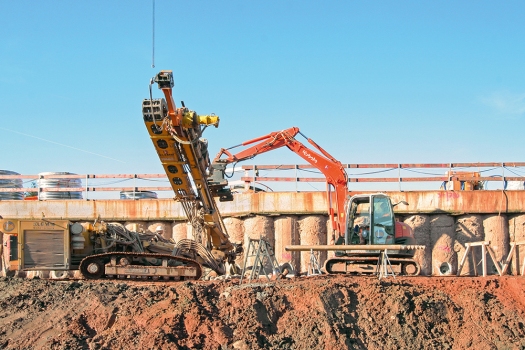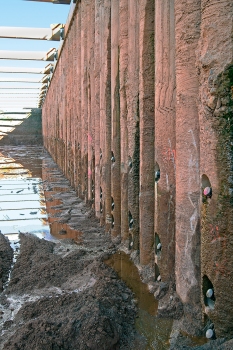New chamber for the Moselle River lock near Trier, Germany
From Koblenz in Germany to Neuves-Maisons in France, the navigable part of the Moselle River has a total length of over 390 km. It is the most heavily travelled inland waterway in Germany. Annually, more than 10,000 cargo ships navigate the Moselle; in the summer months, the river is also used by about 5,000 passenger ships.
With a current transport volume of 15 to 16 million tons per year, the locks have exceeded their capacity, which leads to long wait times. Furthermore, the repair work that has to be carried out on the more than 50 year old locks keep getting more extensive, resulting in full closures of 8 days per year.
10 new locks
To make the waterway sustainable and allow year-round navigation, 10 new locks are being built parallel to the existing lock systems from Koblenz to Trier. The new locks have a navigable length of 210 m and a width of 12.5 m each and can therefore be used by larger ships.
The lock complex in Trier is the third system to be enlarged. The new lock chamber is being erected onshore next to the existing chamber as a monolithic reinforced concrete structure with a 3 m thick base. The excavation needed for the new locks is being constructed directly next to the old locks. Therefore, a reinforced bored pile wall with double tie backs was necessary to stabilize the existing chamber. The complete excavation for the locks is partly built as an overlap bored pile wall and partly as a sheet pile wall.
At the upper offshore terminal, the separating breakwater between the old and the new chamber was built as a bored pile wall supported by four layers of tie backs. The excavation sheet pile wall is also supported by four layers of tie backs, with the first layer employing horizontal tie rods and the other three layers using grouted anchors.
At the lower offshore terminal, the separating breakwater consists of an overlap bored pile wall tied back in four layers. The front sides of the excavation are confined by sheet pile cofferdams. In these areas, tension anchors were used at the top of the wall in addition to the tie back anchors.
Soil mainly consists of five layers
The prevailing soil mainly consists of five layers, with back fills, alluvium, gravel and sand in the upper layers. The drilling work for the bored pile wall and the anchors were carried out in conglomerates of highly abrasive consolidated gravel and in weakly abrasive, partly scaly claystone and siltstone.
To tie back the retaining structures around the excavation, DSI produced and supplied 223 permanent strand anchors with 2, 4, 5, 6 and 7 strands and a total length of 5,313 m as well as 393 temporary strand anchors with 4, 6, 7, 8, 9 and 10 strands and a total length of 6,230 m.
References
Structure Types
- About this
data sheet - Product-ID
7561 - Published on:
03/01/2018 - Last updated on:
17/11/2021





